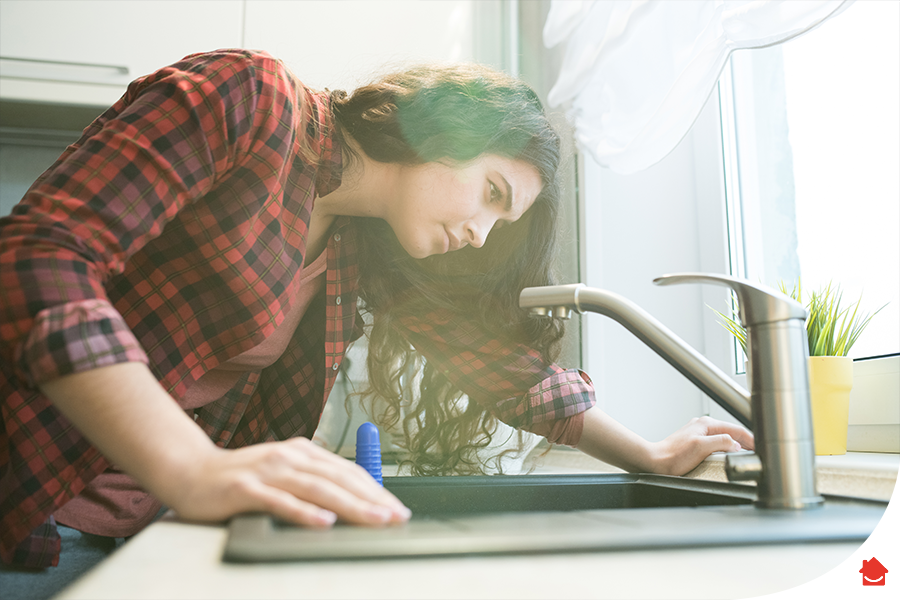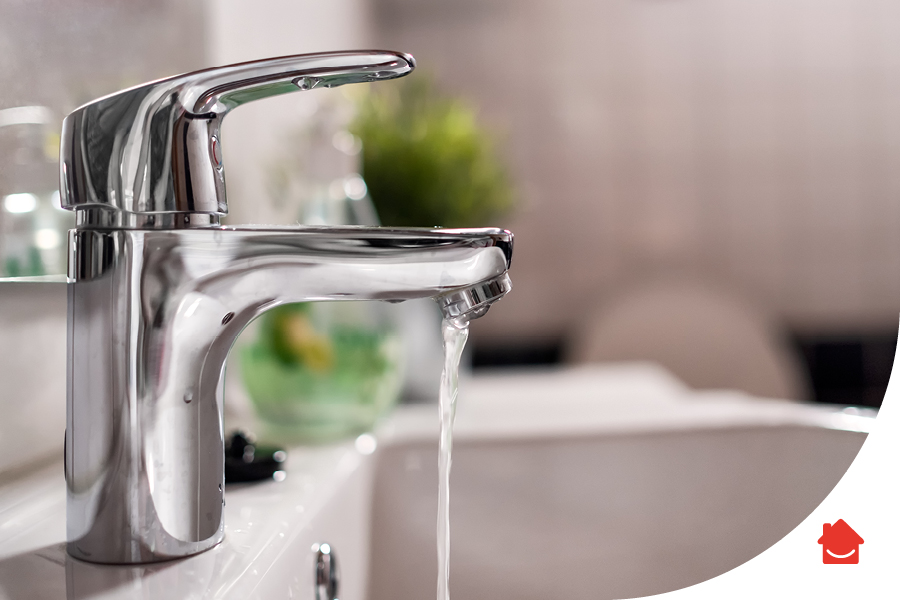A blocked kitchen sink is one of the most common household problems going, mostly due to the fact that we happily let all kinds of food debris, coffee grounds and soap residue slide unceremoniously down the drain. The good news is, blocked drains are one of the easiest home fixes to do for any DIY-er, from beginner to expert!
When you find your kitchen drain completely blocked up, you may be inclined to run to the shops and buy up all the harsh chemical cleaners to cut through the block. But hold up! Before you buy a super-harsh chemical cleaner, know that this is not the only option. In fact, it may end up causing long-term damage to your sink. Plus, backsplash from stubborn blockages can seriously harm your skin and eyes – and the stuff is extremely harmful to our environment. This guide will give you a range of options on how to unblock a sink using common household products, and advice on how to avoid a blockage in future. (As always, if the methods below don’t work and you, therefore, suspect a more serious issue, call in the HomeServe pros.)
Not all drains are created equal, so if you’re having issues with your shower or bathroom drains, then read our handy how-to guide with full step-by-step instructions on how to unblock a bath or shower.
Here are five methods to unblock your blocked kitchen sink:
1. Use boiling water
If you’ve dealt with drain blockages before and are an avid DIY-er, you’ll know boiling water is the easiest and least expensive solution of all, which makes it the best one to try first. Boiling water may be all your pipes need to loosen a blockage made up of grease, soap residue and food debris.
- Boil a full kettle, or boil a pot of water on the stove
- While you’re waiting for the water to heat, remove as much standing water from the sink as you can, using a mug or small pot to bail out the water
- Then, pour the entire kettle of water into the sink and wait
- If the water stands in the sink and the clog doesn’t move, give the water time to cool and remove it to try again.
Top tip: If you have plastic pipes instead of metal ones, switch off your kettle early and use only partially boiled water to avoid damage to your pipes.
You may need to repeat the process several times to move the clog, but this often works on many types of blockages.
If you find your blockage is too much of a monster for this simple method, move on to the next method.
2. Baking soda or effervescent tablet and vinegar
A step up from boiling water, this natural method can be very effective as an alternative to chemicals. This magic mixture includes ingredients you probably already have in your home. Watch the video and/or follow the steps below to learn how to unblock your kitchen sink with baking soda or effervescent tablet and vinegar.
- Remove the water from the sink
Use a mug or a small pot to scoop out water from the sink bit by bit. - Drop two to four effervescent tablet tablets into the plughole
Break them into small pieces so they can travel as deeply down the hole as necessary. Two may be all you need for a slow-moving blockage; use four for a severe clog. You can use effervescent tablet or baking soda. - Pour a cup of white vinegar in after it
Pour the vinegar immediately after inserting the effervescent tablet or baking soda. Allow the chemical reaction to happen – it will bubble up for 10 minutes or until you no longer hear or see bubbling action. - Boil a full kettle while you wait
Or boil a big pan of water on the hob. - Pour the boiled water down the sink
Flush your sink plughole with a fast stream of boiled water, using all the water you’ve got. You may need to repeat this a few times or run your hot water tap to clear it.
Try baking soda and salt
This is another combination that can work to unblock your kitchen sink:
- Mix roughly a cup of baking soda with half a cup of salt
- Pour it down your plughole.
- Let the mixture sit for several hours (you might need to cordon off the sink so no one else uses it).
- Flush it with boiling water.
- Repeat the process if it doesn’t work the first time.
If it seems like you’re making progress on the blockage after a couple of tries, you’ll get there with this method. Repeat until fixed. If your kitchen sink is still backed up, move on to the next method.
3. Unblock your kitchen sink with a plunger
It’s time to get physical. Regretting all those times you washed food remnants down the sink yet? Let’s take the plunge. Make sure you use a flat-bottomed plunger so you can get a really good seal on your plughole.
- If you have a double sink, seal off the second side
You can do this with a wet cloth or a plug stopper. - Fill your sink with hot water
Fill the sink so that it’s about halfway full and creates a seal around the plughole. - Position the plunger over the plughole
Remember to get a good seal, this is key. - Start pumping the plunger up and down quickly
Do this vigorously, several times. - Remove the plunger and wait
If some or all of the water drains, it’s working, your sink is on it’s way to being unblocked! - Worked? Flush the drain well with hot water
And breathe a sigh of relief! - Not quite? Repeat the process until all the water drains freely
If the sink still isn’t draining properly after multiple plunging attempts, time to try a different method.
4. Check the U-bend
The sinks U-bend is the curved bit of the drainpipe underneath your sink. A P-trap is your U-bend plus another bit of piping that altogether resembles a ‘P’ shape. Sometimes food debris collects in the U-bend and turns into gunk, causing your sink to drain slowly or not at all. Here’s how to check and clear it:
-
- Prepare and protect
You’ll need:- Rubber gloves
- Old towels
- A bucket or washing up bowl under the pipe to catch water and debris2.
- Unscrew the P-trap connectors – There’s a slip nut on either end of the P-trap that holds it to the drain pipe.
- Remove the P-trap and clean the pipe of all gunk – Make sure you’re wearing your rubber gloves and the old towels and bucket is at the ready to catch water and debris.
- Reconnect the trap – Reassemble the pipes and P-trap, tightening the connectors by hand. (Pro plumber’s tip: Don’t over-tighten, as you may cause the connectors to crack.)
- Run some hot water down the drain – Is it draining now? If so, congratulations! Check under the sink for any leaks and tighten connectors accordingly. If your problem hasn’t shifted, move onto our final method.
- Prepare and protect
5. Pipe snake
So you’ve got a horribly stubborn blockage, eh? It’s time to bring out the big guns. Sometimes called an auger or a plumber’s snake, a pipe snake is a thin, flexible cable that can reach into the drain to unclog a blockage that may be stuck further down the system. If you don’t have one, you can fashion a wire coat hanger into a homemade plumber’s snake – unwind it so it’s one long wire but keep the hooked end and make it small enough to enter the pipe.
- Disassemble the U-bend or P-trap – Remove your P-trap from in-between your sink and the ‘stub pipe’ or ‘stubout’ that travels behind the cabinet wall. Have a bucket or washing up bowl handy to catch water or sludge. Clean your U-bend/P-trap if necessary.
- Insert the snake into the stub pipe until you feel resistance – Whether you’re using a snake or a coat hanger, feed it down the drain a few feet at a time. Try not to push too hard, as you might accidentally push the blockage further down the pipe. Once the snake hits an obstruction, you’re in business.
- Crank the handle to dislodge the debris and pull it out of the drain – If you’re using a coat hanger, try to hook onto whatever’s in there. Keep pulling stuff out until you feel confident that you’ve unblocked your pipe.
- Reassemble and tighten your P-trap – Again, make sure it’s watertight but don’t over-tighten.
- Run hot water down your drain to check if you’ve unblocked your sink
Congratulations!
How to prevent future blockages
Now you’re a battle-scarred sink unblocker, you may think twice about pouring those daily coffee grounds and bits of food down the sink. It’s actually very easy to make sure your kitchen sink is draining correctly and avoid future blockages.
- Know where to dispose of the items your drain doesn’t like
- Grease, fats and oils: Collect them in an old tin can and once it’s full and sealed, you can put it in your general waste bin. You can also recycle used cooking oil.
- Meat: Food waste bin.
- Coffee grounds: Food waste bin or compost them.
- Egg shells: Food waste bin or compost them.
- Starchy foods, such as pasta, rice or bread: Food waste bin or compost them.
- Fruit peels, pits and stickers: Compost for fruit, bin for stickers)
- Paint: You can’t pour paint away, and you can’t just stick old paint cans in the bin either as liquid paint is banned from landfill. For smaller amounts, pour the paint onto a piece of card or paper and leave it to dry before including it with your household waste. For large amounts, pour in sawdust to your paint can so it will dry up quicker. Dry paint is OK for landfill.
- Paper products like kitchen roll or food wrappers: Recycle them.
- Run hot water down the drain after each sink use
This is a great habit to establish to keep everything clear.- Use a drain cover to catch debris – Just empty it in the bin every day.
- Pour any leftover boiled water from the kettle to kill off bacteria – Another fantastic habit to build: Every time you boil the kettle, just pour what’s left down the plughole.
- Pour baking soda down your drain once a week – This is also a great one to do if you’re going away and won’t be using your sink for a while.
Read more tips right now
Find out How to get rid of kitchen smells and keep your sink smelling fresh and running smoothly.
When to call a professional
If you’ve tried the methods listed in this article and are still having trouble with your kitchen sink not draining, it may be time for a more thorough inspection by a professional. Contact HomeServe and we can arrange for a qualified local plumber to fix and unblock your kitchen sink.





